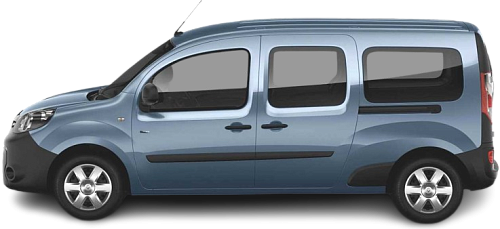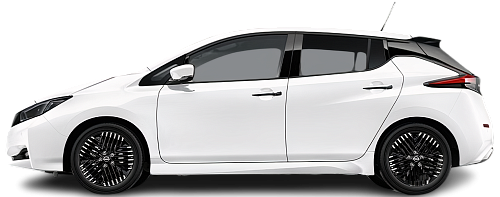USA EV Comparison: Renault Kangoo Z.E. (E-Tech) 33 Maxi vs Nissan Leaf 40 kWh
Struggling to Decide? Let AI Help!
Your AI Summary Is Ready!
General Info
Since both vehicles have been discontinued, they are now only available on the used car market. You can get the Nissan Leaf 40 kWh (2022-2025) for as low as $9999, while the Renault Kangoo Z.E. 33 Maxi (2017-2022) was never offered for sale in the United States.
The Renault Kangoo Z.E. 33 Maxi (2017-2022) is a Minivan, whereas the Nissan Leaf 40 kWh (2022-2025) is a Hatchback.
| Property | Renault Kangoo Z.E. (E-Tech) 33 Maxi | Nissan Leaf 40 kWh |
|---|---|---|
| Years of Production | 2017-2022 | 2022-2025 |
| Current Status | Discontinued | Discontinued |
| Country of Manufacture | France | Japan, UK, USA |
| Body Style | Minivan | Hatchback |
| Market Availability | EU | EU, USA |
| Price USA (Used) | - Price USA (Used) | $9999 |
| GCC Score | 5.2 | 4.8 |
Range and Efficiency
While the Nissan Leaf 40 kWh (2022-2025) offers a longer real-world range and a bigger battery, it is less energy-efficient than the Renault Kangoo Z.E. 33 Maxi (2017-2022).
| Property | Renault Kangoo Z.E. (E-Tech) 33 Maxi | Nissan Leaf 40 kWh |
|---|---|---|
| Range (EPA) | - Range (EPA) | 149 mi |
| Range (WLTP) | 143 mi | 177 mi |
| Range (GCC) | 124 mi | 148 mi |
| Battery Capacity (Nominal) | 33 kWh | 40 kWh |
| Battery Capacity (Usable) | 31 kWh | 39 kWh |
| Efficiency per 100 mi | 25 kWh/100 mi | 26.4 kWh/100 mi |
| Efficiency per kWh | 4 mi/kWh | 3.79 mi/kWh |
| Range and Efficiency Score | 5.7 | 5.6 |
Charging
Both vehicles utilize a standard 400-volt architecture.
The Renault Kangoo Z.E. 33 Maxi (2017-2022) has no DC fast charging capability, whereas the Nissan Leaf 40 kWh (2022-2025) can charge at up to 50 kW.
The Renault Kangoo Z.E. 33 Maxi (2017-2022) features a more powerful on-board charger, supporting a maximum AC charging power of 7 kW, whereas the Nissan Leaf 40 kWh (2022-2025) is limited to 6.6 kW.
| Property | Renault Kangoo Z.E. (E-Tech) 33 Maxi | Nissan Leaf 40 kWh |
|---|---|---|
| Max Charging Power (AC) | 7 kW | 6.6 kW |
| Max Charging Power (DC) | - Max Charging Power (DC) | 50 kW |
| Architecture | 400 V | 400 V |
| Charge Port | Type 2 (Mennekes) | CHAdeMO |
| Charging Score | 3.1 | 3.3 |
Performance
Both vehicles are front-wheel drive.
The Nissan Leaf 40 kWh (2022-2025) boasts greater motor power and accelerates faster from 0 to 60 mph.
| Property | Renault Kangoo Z.E. (E-Tech) 33 Maxi | Nissan Leaf 40 kWh |
|---|---|---|
| Drive Type | FWD | FWD |
| Motor Type | PMSM | PMSM |
| Motor Power (kW) | 44 kW | 110 kW |
| Motor Power (hp) | 59 hp | 148 hp |
| Motor Torque | 166 lb-ft | 236 lb-ft |
| 0-60 mph | 21.8 s | 7.7 s |
| Top Speed | 81 mph | 90 mph |
| Performance Score | 1.4 | 3 |
Dimensions
The Renault Kangoo Z.E. 33 Maxi (2017-2022) is longer, wider, and taller.
The Renault Kangoo Z.E. 33 Maxi (2017-2022) boasts a more extended wheelbase.
| Property | Renault Kangoo Z.E. (E-Tech) 33 Maxi | Nissan Leaf 40 kWh |
|---|---|---|
| Length | 183.7 in | 176.4 in |
| Width (with Mirrors) | 84.2 in | 79.9 in |
| Width (w/o Mirrors) | 72 in | 70.5 in |
| Height | 70.9 in | 61.5 in |
| Wheelbase | 121.3 in | 106.3 in |
Cargo and Towing
The Renault Kangoo Z.E. 33 Maxi (2017-2022) provides more cargo capacity, featuring both a larger trunk and more space with the rear seats folded.
Neither car is equipped with a frunk (front trunk).
The Renault Kangoo Z.E. 33 Maxi (2017-2022) has a towing capacity of up to 710 lb, whereas the Nissan Leaf 40 kWh (2022-2025) is not officially rated for towing in the US.
| Property | Renault Kangoo Z.E. (E-Tech) 33 Maxi | Nissan Leaf 40 kWh |
|---|---|---|
| Number of Seats | 5 | 5 |
| Curb Weight | 3494 lb | 3509 lb |
| Cargo Volume (Trunk) | 45.9 ft3 | 23.6 ft3 |
| Cargo Volume (Max) | 120.1 ft3 | 30 ft3 |
| Cargo Volume (Frunk) | - Cargo Volume (Frunk) | - Cargo Volume (Frunk) |
| Towing Capacity | 710 lb | - Towing Capacity |
| Cargo and Towing Score | 8 | 4.5 |




